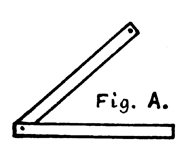Home >Directory of Drawing Lessons > How to Improve Your Drawings > Measuring and Proportions > Finding Angles of Objects & Slants of Lines
Tips and Techniques for Judging the Angles & Slants of the Edges / Lines of Objects & Subjects that You are Drawing
|
|
Directions for Finding the Apparent Slant of Edges or Lines.1. Hold with both hands, one hand at each end, a pencil, a ruler, a straight stick, or a string, at arm's length, between one eye (the other being closed) and the line or edge to be drawn, so that the pencil or string shall always be at right angles to the line of direction and both hands equally distant from the eye. 2. Revolve the string by raising or lowering one hand, until the string just coincides with or hides the edge or line to be viewed. In doing this, one hand must never be brought nearer the eye than the other. When the string hides the edge to be viewed, notice how much it differs from a vertical or a horizontal direction, and draw a line on the paper having the same slant as the string or stick.
3. Another method is to procure a jointed ruler, or two strips of wood or cardboard fastened at one end so as to open and close like the blades of a pair of scissors, as shown in Fig. A. Hold this implement in a plane at right angles to the line of direction, with one blade vertical, and move the other blade so as to coincide with the apparent slant of the rod or edge to be viewed. By laying this instrument on the paper with one blade vertical, that is, pointing to and from the body, the other blade will show the proper slant required. Or one blade may be held exactly horizontal and the other one moved so as to coincide with the apparent slant of the rod or edge. Now, lay the jointed ruler on the paper with one blade horizontal, or pointing directly left and right, and the other blade will show the apparent slant of the rod, or edge. An investigation of straight edges, according to these and previous directions, will lead to an understanding of the following:—Principles to be Observed in Representing Straight Edges1. When straight edges or lines are vertical in space, that is, in the object, they must be drawn vertical. 2. When the ends of a straight line or an edge are equally distant from the eye, its apparent direction, or slant, will be the same as its real direction. 3. When straight edges or lines in the object appear to run directly right and left, they must be drawn horizontal. 4. When a straight line or an edge is in the line of direction, it must be drawn as a point. A line that has one end nearer the eye than the other is called a retreating line. 5. When straight horizontal retreating edges are in a vertical plane passing through the eye of the spectator, they must be drawn vertical. 6. When straight horizontal retreating edges are on a level with the eye, they must be drawn horizontal. 7. When straight horizontal retreating lines or edges are below the level of the eye, they must be drawn slanting upward in the direction of their retreat. 8. When straight horizontal retreating lines or edges are above the level of the eye, they must be drawn slanting downward in the direction of their retreat. 9. The farther a straight horizontal retreating edge is above or below the level of the eye, the more nearly vertical it must be drawn. 10. The farther a straight horizontal retreating edge is to the right or the left, of the eye, the more nearly horizontal it must be drawn. |
Privacy Policy ...... Contact Us





